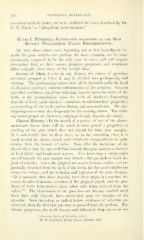Page 512 - My FlipBook
P. 512
a
510 PYORRHEA ALVEOLARIS.
associated with tlie latter, are to be included the cases described ])y Dr.
G. \ . Black ' as '* phagedenic pericementitis."
Class I. Pyorrhea Alveolaris beginning at the Gum
Margin (Ptyalogenic Calcic Pericementitis).
The first class—those cases beginning not at, but immediately be-
neath the gum margin— are perhaps the most common, are by some
erroneously supposed to be the only type of cases, and will require
description first, as their causes, progress, prognosis, and treatment
differ radically from those of the second class.
Causes of Class I.—As in any disease, the causes of pyorrhea
alveolaris grouped as Class I. may be divided into predisposing and
exciting. The predisposing causes may all be included under the head
of disorders causing a subacute inflammation of the gingivae. General
catarrhal conditions; small but irritating deposits upon the necks of the
teeth, as the accumulations upon the teeth of smokers ; fermenting
deposits of food ; spirit-drinkers' stomatitis, mouth-breathers' gingivitis ;
overcrowding of the teeth, mal-occlusion, and non-occlusion. The pre-
disposing causes may also frequently be the exciting causes. The excit-
ing causes proper are, however, subgingival scaly deposits of calculi.
Clinical History.—In the mouth of a patient of one of the above-
mentioned classes there will be noted at some period a gingivitis—
swelling of the gum which does not extend far from their margins.
It is noteworthy that in these cases, as in the succeeding class, it is
usual to find the disease attack teeth which are comparatively or quite
exempt from the inroads of caries. Soon after the incipiency of the
disease there may be squeezed from beneath the gum margins a detritus
of food debris and inspissated mucus. At a later stage a sharp scaler
passed beneath the gum margin may detach a flat greenish or black de-
posit of calculus. Later, the gingivfe are seen to become swollen and are
gradually detached from the neck of the tooth, the flattened calculus in-
creases in volume, and the irritation and injection of the gum deepens.
'' It is probable that these deposits have their origin in a reaction be-
tween the altered mucous secretion of the gingival glands and the pro-
ducts of lactic fermentation, their calcic salts being derived from the
saliva." ^ The detachment of the gum does not become marked until
these dark scaly deposits have encroached upon the margins of the
alveolus. Soon thereafter, or indeed before, evidences of infection are
observed, from the fact that pus may be pressed from the pockets. The
disease progresses, the teeth loosen, and ultimately drop out or are re-
^ American Si/Mem of Dentistry, vol. i.
^ H. H. Bnrchard, Dental Cosmos, October, 1895.
510 PYORRHEA ALVEOLARIS.
associated with tlie latter, are to be included the cases described ])y Dr.
G. \ . Black ' as '* phagedenic pericementitis."
Class I. Pyorrhea Alveolaris beginning at the Gum
Margin (Ptyalogenic Calcic Pericementitis).
The first class—those cases beginning not at, but immediately be-
neath the gum margin— are perhaps the most common, are by some
erroneously supposed to be the only type of cases, and will require
description first, as their causes, progress, prognosis, and treatment
differ radically from those of the second class.
Causes of Class I.—As in any disease, the causes of pyorrhea
alveolaris grouped as Class I. may be divided into predisposing and
exciting. The predisposing causes may all be included under the head
of disorders causing a subacute inflammation of the gingivae. General
catarrhal conditions; small but irritating deposits upon the necks of the
teeth, as the accumulations upon the teeth of smokers ; fermenting
deposits of food ; spirit-drinkers' stomatitis, mouth-breathers' gingivitis ;
overcrowding of the teeth, mal-occlusion, and non-occlusion. The pre-
disposing causes may also frequently be the exciting causes. The excit-
ing causes proper are, however, subgingival scaly deposits of calculi.
Clinical History.—In the mouth of a patient of one of the above-
mentioned classes there will be noted at some period a gingivitis—
swelling of the gum which does not extend far from their margins.
It is noteworthy that in these cases, as in the succeeding class, it is
usual to find the disease attack teeth which are comparatively or quite
exempt from the inroads of caries. Soon after the incipiency of the
disease there may be squeezed from beneath the gum margins a detritus
of food debris and inspissated mucus. At a later stage a sharp scaler
passed beneath the gum margin may detach a flat greenish or black de-
posit of calculus. Later, the gingivfe are seen to become swollen and are
gradually detached from the neck of the tooth, the flattened calculus in-
creases in volume, and the irritation and injection of the gum deepens.
'' It is probable that these deposits have their origin in a reaction be-
tween the altered mucous secretion of the gingival glands and the pro-
ducts of lactic fermentation, their calcic salts being derived from the
saliva." ^ The detachment of the gum does not become marked until
these dark scaly deposits have encroached upon the margins of the
alveolus. Soon thereafter, or indeed before, evidences of infection are
observed, from the fact that pus may be pressed from the pockets. The
disease progresses, the teeth loosen, and ultimately drop out or are re-
^ American Si/Mem of Dentistry, vol. i.
^ H. H. Bnrchard, Dental Cosmos, October, 1895.


